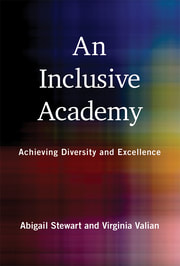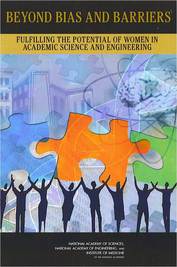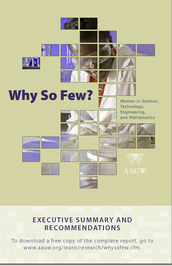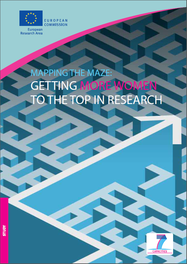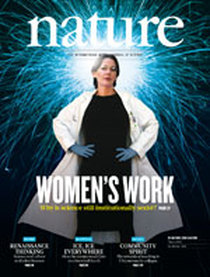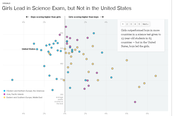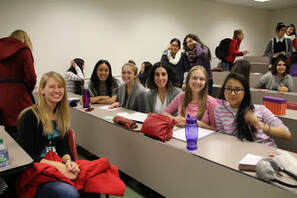Readings
Some highlights
An Inclusive Academy: Achieving Diversity and Excellence. A must-read for any academic. A timely update to the fabulous Why so slow? The advancement of women. These books lay out scientifically supported, evidence-based issues related to disparities in advancement based on gender, race, and more. Learn why these differences will not dissipate simply by the passage of time.
Resources on hiring, implicit bias, and more from the Society for Neuroscience
Nice report and guidance from Australian Academy of Science on increasing diversity in awards.
Online report from the National Academies (USA): Beyond Bias and Barriers: Fulfilling the Potential of Women in Academic Science and Engineering
The National Academies investigated barriers women face in science. The full report is informative, evidence-based documentation of causes and solutions. ***A must read for anyone who is or interacts with a woman in science.***
Below are short highlights of interesting topics in the report
Summary: the findings of the report.
Misconceptions: Evidence refuting common beliefs about causes for gender disparity in science.
How Johns Hopkins improved retention and promotion of women faculty without changing evaluation criteria
The NIH Pioneer Award: how small changes make a big impact on diversity in grant awards (read through to second page for the full story).
Resources on hiring, implicit bias, and more from the Society for Neuroscience
Nice report and guidance from Australian Academy of Science on increasing diversity in awards.
Online report from the National Academies (USA): Beyond Bias and Barriers: Fulfilling the Potential of Women in Academic Science and Engineering
The National Academies investigated barriers women face in science. The full report is informative, evidence-based documentation of causes and solutions. ***A must read for anyone who is or interacts with a woman in science.***
Below are short highlights of interesting topics in the report
Summary: the findings of the report.
Misconceptions: Evidence refuting common beliefs about causes for gender disparity in science.
How Johns Hopkins improved retention and promotion of women faculty without changing evaluation criteria
The NIH Pioneer Award: how small changes make a big impact on diversity in grant awards (read through to second page for the full story).
Women in Science and Engineering Leadership Institute has released an updated guide: "Searching for Excellence and Diversity: A Guide for Search Committees"
Gender Bias in Science and Research Series - A four part series which aired on CBC Radio Active September 2016
Some fun tools
What is the gender bias in your reference list? Find out here.
Gender Bias Calculator. Paste in a recommendation letter to see which words you choose are more frequently associated with women or men.
Gender Bias Calculator. Paste in a recommendation letter to see which words you choose are more frequently associated with women or men.
Recent Articles
Teaching in the eye of the beholder: Study of online ratings of professors suggests scores vary with an instructor’s gender, discipline and perceived “easiness.”
Stuck in the Out-Group: Jennifer Can't Grow Up, Jane's Invisible, and Janet's Over the Hill: How bias affects women at all career stages
Stuck in the Out-Group: Jennifer Can't Grow Up, Jane's Invisible, and Janet's Over the Hill: How bias affects women at all career stages
|
Special Supplement in Nature for 2012 International Women's Day.
Includes:
|
|
Recent NY Times graphic on how girls outperform boys in science in more countries, but not the US, UK, or Canada
|
|
Globe and Mail examines "The XX Factor: Women in Science" :
Looking worldwide for the women Canada needs How some universities are attracting more women to math, science programs Science careers start with young girls Also see The trouble with targeting women for science programs and female academics excluded from recognition and equal pay: study. |
Nature introduces a policy to reduce implicit bias in editorial decisions: "Nature's sexism".
Council of Canadian Academies report: Strengthening Canada's Research Capacity: the Gender Dimension.
2012 PNAS article: Science faculty's subtle gender biases favor male students. Also see the discussion of the article in New York Times forum.
Informal compensation practices disadvantage University women A blurb in Nature covering a recent study that shows women miss out on informal benefits.
Article by former Director in the US State Department: "Why women still can't have it all"
Understanding current causes of women's under-representation in science (2011) This article in the Proceedings of the National Academy of Sciences suggests that current policies attempting to redress gender imbalance may be focused on historical issues, and miss the problems facing us today.
Gender Bias in Academe: An Annotated Bibliography of Important Recent Studies
Bias in Student Evaluations
Council of Canadian Academies report: Strengthening Canada's Research Capacity: the Gender Dimension.
2012 PNAS article: Science faculty's subtle gender biases favor male students. Also see the discussion of the article in New York Times forum.
Informal compensation practices disadvantage University women A blurb in Nature covering a recent study that shows women miss out on informal benefits.
Article by former Director in the US State Department: "Why women still can't have it all"
Understanding current causes of women's under-representation in science (2011) This article in the Proceedings of the National Academy of Sciences suggests that current policies attempting to redress gender imbalance may be focused on historical issues, and miss the problems facing us today.
Gender Bias in Academe: An Annotated Bibliography of Important Recent Studies
Bias in Student Evaluations
Resources, information, and actions you can take (not just for women)
The Gender Equity project. Ongoing research, tutorials, and information about gender equity in academia.
Resources from the Women in Science and Engineering Leadership institute.
Specific resources include brochures (free download):
Reviewing Applicants: Research on Bias and Assumptions
Benefits and Challenges of Diversity in Academic Settings
Enhancing Department Climate: A Guide for Department Chairs
Fostering Success for Women in Science and Engineering: Advice for Departmental Faculty
Advancing Women in Science and Engineering: Advice to the Top
And a free guidebook: Reaching for Excellence & Diversity: A Guide for Search Committees
Shareable infographic on avoiding bias in reference letters here.
Work-life balance: a GREAT list of links to articles, blog posts, and other helpful ideas on how to manage career and family (by the Committee on the Status of Women in Astronomy. Their home page, resources, and advice are also wonderful: they have been recommending practical measures to improve the status of women in Astronomy since 1979! They have an awesome email newsletter, too.
National Postdoc Association: From PhD to Professoriate. How institutions can support female postdocs through their next career steps.
How to increase diversity in your institution. A great list of resources!
How to manage pregnancy/maternity leave: from health and safety to planning tips (and useful for more than just postdocs) Family-friendly resources for postdocs
Advice for mentors and mentees from a JAMA commentary. It includes several references suggesting mentoring boosts careers.
National Science Foundation research report: "Why so few?", and the associated New York Times article. Bias and stereotypes still pose significant hurdles to women in science.
*How we can all be sexist: A brief overview of some research into the effects of unconscious bias* Think your egalitarian views prevent sexist behaviour? Think that women are less sexist than men? Think again.
*The economics of retaining women* The cost of failure to retain and promote female academics from Tools for Change in STEM (WorkLife Law).
*Gender bias in academia* Summaries of hundreds of studies and a good overall resource for academics from Tools for Change in STEM (WorkLife Law).
*Achieving diversity in recruitment* Want to hire more women? Find out how.
*Sex and Science: Tips for Faculty* Compiled by the Women in Science & Engineering Leadership Institute, this pdf describes actions all can take to improve their workplace environment. The illustrations of workplace 'climate' are also interesting. Here are a few examples of workplace climate.
*How we inadvertently hinder those we try to support (or, how to write a letter of recommendation)* At the end of this PDF, Howard Hughes Medical Institute (HHMI) show examples of how language used in a reference letter can give different impressions of two candidates with very similar qualifications. A number of studies show that letter writers tend to use stronger terms for male candidates than for female candidates.
*If MIT can do it, so can we. Diversification of a University Faculty: Observations on Hiring Women Faculty in the Schools of Science and Engineering at MIT*. This report documents the efforts made by MIT to improve diversity in their science and engineering departments. They find that usual departmental hiring processes do not always identify exceptional female candidates. Also, they suggest that increases in the representation of women and minorities don't just "happen," but result from specific pressures, policies, and positive initiatives; and that when these pressures abate or expire, hiring progress stops or even reverses.
*How not to break the law: Positive Action versus Positive Discrimination*: Generally, "positive discrimination" is prohibited in employment. "Positive action" however, is permitted and may even be required in certain circumstances (particularly for public sector organizations)
Resources from the Women in Science and Engineering Leadership institute.
Specific resources include brochures (free download):
Reviewing Applicants: Research on Bias and Assumptions
Benefits and Challenges of Diversity in Academic Settings
Enhancing Department Climate: A Guide for Department Chairs
Fostering Success for Women in Science and Engineering: Advice for Departmental Faculty
Advancing Women in Science and Engineering: Advice to the Top
And a free guidebook: Reaching for Excellence & Diversity: A Guide for Search Committees
Shareable infographic on avoiding bias in reference letters here.
Work-life balance: a GREAT list of links to articles, blog posts, and other helpful ideas on how to manage career and family (by the Committee on the Status of Women in Astronomy. Their home page, resources, and advice are also wonderful: they have been recommending practical measures to improve the status of women in Astronomy since 1979! They have an awesome email newsletter, too.
National Postdoc Association: From PhD to Professoriate. How institutions can support female postdocs through their next career steps.
How to increase diversity in your institution. A great list of resources!
How to manage pregnancy/maternity leave: from health and safety to planning tips (and useful for more than just postdocs) Family-friendly resources for postdocs
Advice for mentors and mentees from a JAMA commentary. It includes several references suggesting mentoring boosts careers.
National Science Foundation research report: "Why so few?", and the associated New York Times article. Bias and stereotypes still pose significant hurdles to women in science.
*How we can all be sexist: A brief overview of some research into the effects of unconscious bias* Think your egalitarian views prevent sexist behaviour? Think that women are less sexist than men? Think again.
*The economics of retaining women* The cost of failure to retain and promote female academics from Tools for Change in STEM (WorkLife Law).
*Gender bias in academia* Summaries of hundreds of studies and a good overall resource for academics from Tools for Change in STEM (WorkLife Law).
*Achieving diversity in recruitment* Want to hire more women? Find out how.
*Sex and Science: Tips for Faculty* Compiled by the Women in Science & Engineering Leadership Institute, this pdf describes actions all can take to improve their workplace environment. The illustrations of workplace 'climate' are also interesting. Here are a few examples of workplace climate.
*How we inadvertently hinder those we try to support (or, how to write a letter of recommendation)* At the end of this PDF, Howard Hughes Medical Institute (HHMI) show examples of how language used in a reference letter can give different impressions of two candidates with very similar qualifications. A number of studies show that letter writers tend to use stronger terms for male candidates than for female candidates.
*If MIT can do it, so can we. Diversification of a University Faculty: Observations on Hiring Women Faculty in the Schools of Science and Engineering at MIT*. This report documents the efforts made by MIT to improve diversity in their science and engineering departments. They find that usual departmental hiring processes do not always identify exceptional female candidates. Also, they suggest that increases in the representation of women and minorities don't just "happen," but result from specific pressures, policies, and positive initiatives; and that when these pressures abate or expire, hiring progress stops or even reverses.
*How not to break the law: Positive Action versus Positive Discrimination*: Generally, "positive discrimination" is prohibited in employment. "Positive action" however, is permitted and may even be required in certain circumstances (particularly for public sector organizations)
Organisations for Women in Science
UK Resource Centre for Women in Science, Engineering and Technology or the WISC Campaign is a comprehensive resource for women and men.
Check out:
University of Cambridge Women in Science, Engineering, and Technology Initiative (WiSETI)
Association for Women in Science (AWiS) Highlights include their Career Library resources, Awards/Funding, and the Mentoring handbook
Women in Cognitive Science (USA)
Women in Neuroscience Includes achievement and travel award info, sfn mentoring program info
NIH Women of Color Research Network Up-to-date news on front page, helpful NIH resources, and a list of 50 must-read female bloggers
Check out:
- their services information about career breaks, your rights, and more.
- their resources page: including good practice guides on mentoring, recruitment, workplace culture, and more.
- their research into how the media portrays female scientists.
- Their database for women in science. You can join, or use it to find female scientists in particular areas.
University of Cambridge Women in Science, Engineering, and Technology Initiative (WiSETI)
Association for Women in Science (AWiS) Highlights include their Career Library resources, Awards/Funding, and the Mentoring handbook
Women in Cognitive Science (USA)
Women in Neuroscience Includes achievement and travel award info, sfn mentoring program info
NIH Women of Color Research Network Up-to-date news on front page, helpful NIH resources, and a list of 50 must-read female bloggers
|
Western WINS! Western's Women in Neuroscience group
Western's Women in Science - Website and Facebook Page (come to our WoW get-togethers!) Seen left, Impostor Syndrome workshop with Dr. Grahn Western's Resources for Women in Academe |
